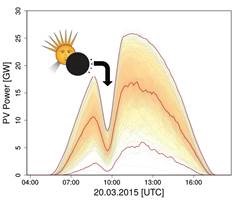Nov 6 2015
The solar eclipse on the 20th of March 2015 severely affected the photovoltaic power supply in Germany, but these effects were well compensated by imports from neighboring countries, according to a study conducted by researchers at the Fraunhofer Institute for Solar Energy Systems in Germany.

The study based on simulation and evaluation of real data is published in the journal Energy Technology.
Photovoltaic technology has reached a considerable share of the electric power generation in Germany. During operation, the photovoltaic modules develop a rising electric power gradient in the morning hours, which then slows down to give a negative gradient minimum in the afternoon, and finally reaches zero again at sunset.
Although certain fluctuations in this smooth gradient curve are warranted by the changing weather conditions, these effects are never as sharp as those of a solar eclipse, which would reduce the solar irradiation abruptly and to a much larger extent. Such an abrupt change could bring instability to the electrical grid and endanger the continuity of the electrical supply for energy consumers.
During the solar eclipse on 20th March 2015, the reduction of the incoming solar irradiance was expected to be about two-thirds as much as the maximum drop, either under clear or overcast sky, as Sven Killinger and his co-authors at the Fraunhofer Institute for Solar Energy Systems in Freiburg, Germany, explain. Such shadowing causes a sudden drop in the power gradient, followed by a steep rise and a maximum peak while the moon's shadow passes by.
Beyond just proposing possible effects on the electricity grid, Killinger and his colleagues were interested in real data.
Measured data is used as the basis for the simulation of the actual PV power in Germany
Sven Killinger - Fraunhofer Institute for Solar Energy System
Their simulation therefore included the data from 160 photovoltaic plants all over Germany, not only for the actual day of the eclipse, but also for other days in mid-March during the previous four years to form a complete picture of the variations possible.
For the morning hours on March 20th, the results of the simulation showed that the power gradient of the photovoltaic plants suffered the expected two sharp peaks, the magnitudes of which were two to three times higher than the typical values on an average day for that time of year. Are these fluctuations manageable for the electrical grid? The authors state yes:
From a technical point of view, and assuming no further challenges, (it) seems to be technically feasible for the German grid to handle.
Sven Killinger - Fraunhofer Institute for Solar Energy System
But what about the loss of photovoltaic power share during the hour of the eclipse? The researchers analyzed power generation data from different technologies in Germany as well as the numbers for imported and exported power. That data painted a clear picture: During the eclipse, the amount of imported power rose and the amount of exported power fell accordingly.
The interaction with the neighboring countries can be considered to be a primary instrument to compensate for the real effects of a solar eclipse.
Sven Killinger - Fraunhofer Institute for Solar Energy Systems
Thus the high incorporation of renewable energy sources in Germany passes its latest test, which bodes well for the German energy transition going forward, in spite of any celestial interference from the moon.